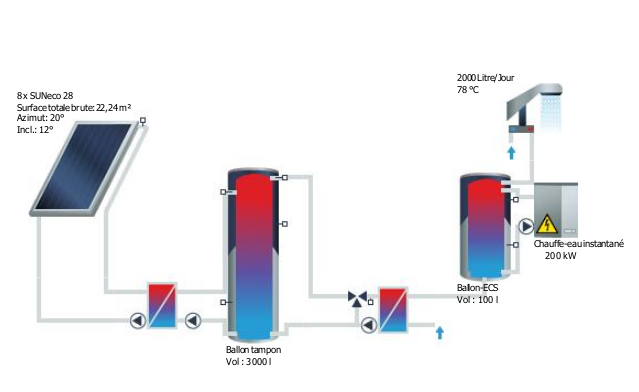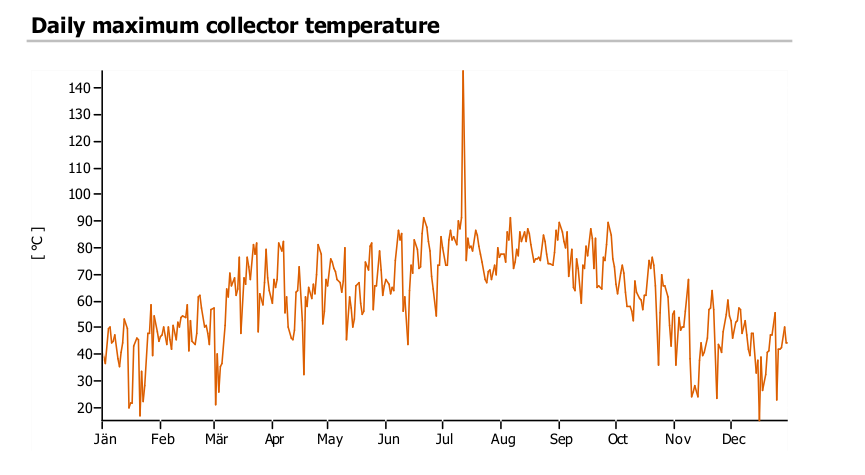Solar panels, thermal and photovoltaic - the differences

So, you are considering buying solar panels for your roof. You have found out that there are two main types, those that produce hot water: solar thermal panels and those that produce electricity: solar photovoltaic panels. You only have one roof. So what would be the be the more efficient use of your available space? Solar thermal or solar photovoltaic? Not everyone arrives at the same answer, but we think that you will find the following information useful in arriving at your own.
Energy storage options:
Very cheap energy storage is possible with solar thermal systems, large insulated tanks of water can be heated, at differing levels to provide more useful temperatures (stratified charging), this heat can be easily stored and used to heat water later on. For smaller systems domestic systems your hot water tank is heated directly, via a serpentine, a larger store than usual is chosen to get you though days without sun.
Currently electrical storage of surplus photovoltaic generation uses Lithium Iron Phosphate batteries and costs over 600 €/kWh to install = very expensive! It is of course possible to store the energy produced by the solar photovoltaic system by heating hot water, especially if this was to be its final destination anyway.
Maintenance:
Solarthermal systems require an annual service and need to have their antifreeze replaced every 5 years, more frequently if there is regular stagnation of the system (see the next point). Components such as the pump and solar expansion vessel will need to be replaced during the 20 year life of the system. The frequency of these replacements will be greater if the system is operated at higher temperatures. For a system >20m2 (Panel area) expect an annual bill of 400 € for the maintenance
Producing and storing hot water at scale with a large solar panel area is hydraulically complex. Plate heat exchangers are required either side of the thermal store. The heat exchangers require pumps to operate to transfer the heat, 2 on the solar side of the store, one on the hot water side (the second pump on the hot water side being replaced by water pressure of the mains supply). This plumbing complexity makes it difficult to find engineers who are competent to work on such systems. It also increases the risk of a breakdown because there are more moving parts.
Photovoltatic systems need no mainteance. The modules can be washed from time to time if they have been made dirty, for example, by dust carried up from the Sahara desert. The system can be monitored very well by its user who can call a photovoltaic technician if there appears to be problem with production. Production expectations are easily found using previous equivalent months’ data; available after the installation’s first year of production. The panels are expected to last for 25-30 years. The inverters 10 years.
Production limits:
Solar thermal systems are limited in their production by the size of the thermal store that they are connected to. If it were possible to have an infinitely large thermal store then every joule of solar heat could be sent into it from the roof. With finite stores, used to produced finite amounts of hot water, they eventually reach a maximum temperature at which point it is no longer possible to use them for energy storage. At this point the solar system goes into ‘stagnation’*. The pumps stop and the flow rate in the collectors falls to zero. This is when very high temperatures can be obtained in the collectors, 200 degrees centigrade is not uncommon in flat plate collectors and it can be much more with vacuum tubes. There is necessarily an increase in the pressure of the antifreeze system at this point also. These elevated temperatures and pressures cause wear and eventual failure of the components in the solar system. The components affected are the heat transfer fluid, rubber joints and seals, the pumps and the expansion vessel(s). This is why it is very important to avoid stagnation as much as possible. Avoiding stagnation events is one of the main criteria in the correct dimensioning of solar system components at the design stage.
Solar photovoltaic systems have no electrical production limits, that which is not used on site passes out on to the electricity network - which could be regarded as a battery of infinite size. The distribution network operator may impose limits on the amount of power injected into their network. However should it happen, you should not let these external limits constrain your solar ambitions! Modern inverters are capable of limiting the amount of power that they inject into the network and there are myriad ways to increase self-consumption, but more of that in another blog . . .

Benefits to surplus production:
Simply put Solar thermal systems are penalised for surplus production*. If there is surplus energy available it will put the system into stagnation, as described above this is an unenviable situation.
La production excédentaire d’électricité par un système photovoltaïque est injectée dans le réseau et payée par votre fournisseur d’électricité selon les règles de l’obligation d’achat en France.
*Unless the solar thermal system is a drain-back one, in which case the heat transfer fluid drains back into an insulated box in the roof space until it is needed again. Drain back systems are the best type of solar thermal technology but they are not seen very often, much is the pity.